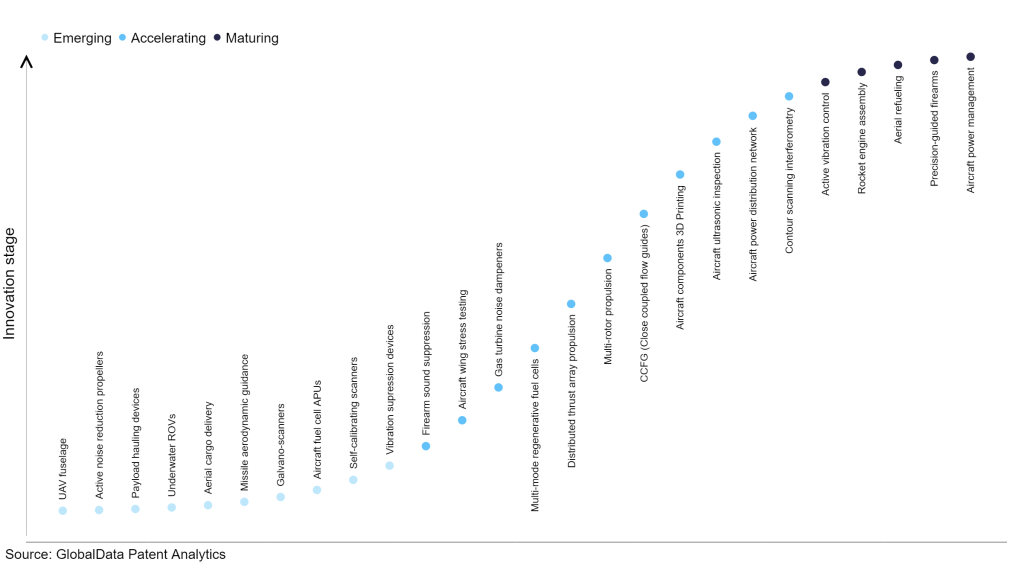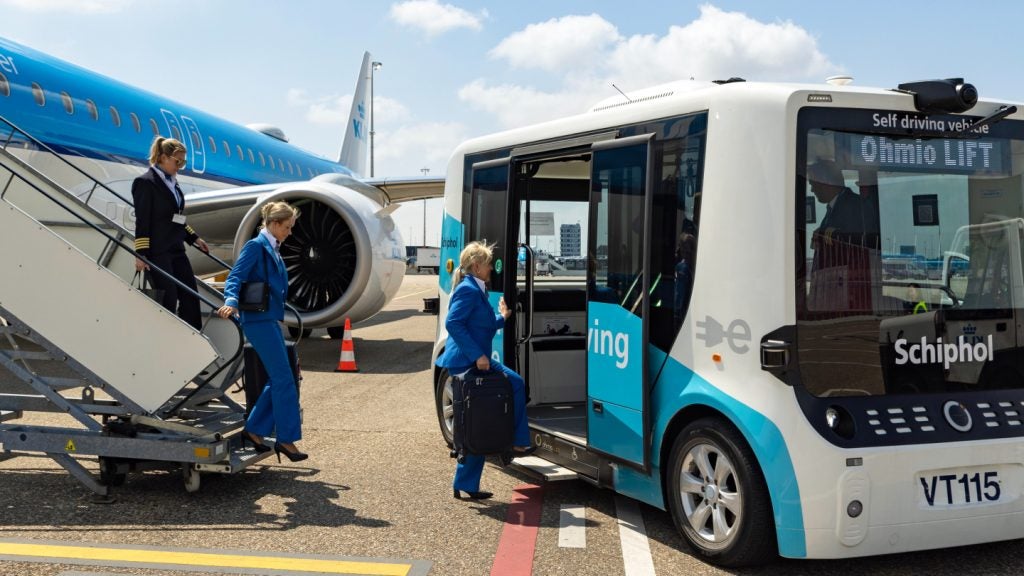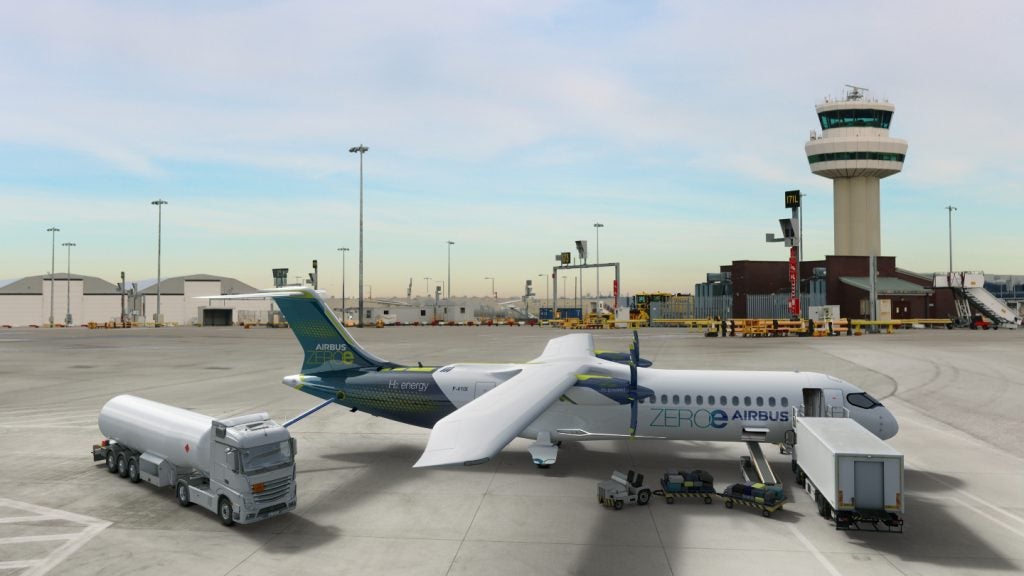The aerospace and defense industry continues to be a hotbed of patent innovation. Activity is driven by automation, environmental sustainability, and operational efficiency, and growing importance of technologies such as artificial intelligence (AI), Internet of Things (IoT), unmanned systems and satellites. As modernization requirements continue to drive investment within both the civil and military aerospace sectors, widespread demand for rocket propulsion solutions has incentivized significant innovation within the field of rocket engine assembly. By leveraging emerging technologies and capabilities such as 3D Printing, artificial intelligence, advanced materials and digital simulation technologies, numerous civilian and defense focused systems integrators have been spearheading the development of novel processes and solutions in this domain. In the last three years alone, there have been over 237,000 patents filed and granted in the aerospace and defense industry, according to GlobalData’s report on Innovation in defense: rocket engine assembly. Buy the report here.
However, not all innovations are equal and nor do they follow a constant upward trend. Instead, their evolution takes the form of an S-shaped curve that reflects their typical lifecycle from early emergence to accelerating adoption, before finally stabilizing and reaching maturity.
Identifying where a particular innovation is on this journey, especially those that are in the emerging and accelerating stages, is essential for understanding their current level of adoption and the likely future trajectory and impact they will have.
110 innovations will shape the aerospace and defense industry
According to GlobalData’s Technology Foresights, which plots the S-curve for the aerospace and defense industry using innovation intensity models built on over 206,000 patents, there are 110 innovation areas that will shape the future of the industry.
Within the emerging innovation stage, aircraft fuel cell APUs, self-calibrating scanners, and vibration supression devices are disruptive technologies that are in the early stages of application and should be tracked closely. Aircraft ultrasonic inspection, aircraft power distribution network, and contour scanning interferometry are some of the accelerating innovation areas, where adoption has been steadily increasing. Among maturing innovation areas are precision-guided firearms and aircraft power management, which are now well established in the industry.
Innovation S-curve for the aerospace and defense industry

Rocket engine assembly is a key innovation area in aerospace and defense
A rocket engine assembly is a rocket propulsion solution comprised of several inter-connected subcomponents including combustors, cooling systems, exhaust nozzles, injectors and various connections which enable different systems to work in harmony. The design and manufacture of these subcomponents is subject to rigorous safety and quality standards as they must be capable of withstanding extreme environmental pressures including the heat, pressure and vibration caused by rocket launches.
GlobalData’s analysis also uncovers the companies at the forefront of each innovation area and assesses the potential reach and impact of their patenting activity across different applications and geographies. According to GlobalData, there are 10+ companies, spanning technology vendors, established aerospace and defense companies, and up-and-coming start-ups engaged in the development and application of rocket engine assembly.
Key players in rocket engine assembly – a disruptive innovation in the aerospace and defense industry
‘Application diversity’ measures the number of applications identified for each patent. It broadly splits companies into either ‘niche’ or ‘diversified’ innovators.
‘Geographic reach’ refers to the number of countries each patent is registered in. It reflects the breadth of geographic application intended, ranging from ‘global’ to ‘local’.
Patent volumes related to rocket engine assembly
| Company | Total patents (2021 - 2023) | Premium intelligence on the world's largest companies |
| IHI | 6 | Unlock Company Profile |
| Centre National de la Recherche Scientifique | 1 | Unlock Company Profile |
| Boeing | 8 | Unlock Company Profile |
| Airbus | 9 | Unlock Company Profile |
| Deutsches Zentrum fur Luft- und Raumfahrt | 3 | Unlock Company Profile |
| Mitsubishi Heavy Industries | 15 | Unlock Company Profile |
| UAB NanoAvionika | 3 | Unlock Company Profile |
| ArianeGroup | 4 | Unlock Company Profile |
| Bradford Engineering | 41 | Unlock Company Profile |
| Galactic Energy | 1 | Unlock Company Profile |
| Centre National Research Scientific | 6 | Unlock Company Profile |
| Multiply Marketing Consultancy | 1 | Unlock Company Profile |
| Radian Aerospace | 4 | Unlock Company Profile |
Source: GlobalData Patent Analytics
Bradford Engineering is one of the leading patent filers in rocket engine assembly. It, through subsidiary ECAPS, filed patents related to oxidizer-rich liquid monopropellants for a dual mode chemical rocket engine, rocket engine ignition system, dual mode chemical rocket engine and dual mode propulsion system comprising the rocket engine, and liquid propellant chemical rocket engine reactor thermal management system.
Some other key patent filers in this space include Airbus, Boeing, and ArianeGroup.
In terms of application diversity, Deutsches Zentrum fur Luft- und Raumfahrt, Bradford Engineering, and Boeing are some of the leading innovators. By means of geographic reach, some of the leading patent filers include Radian Aerospace, UAB NanoAvionika, and Galactic Energy.
To further understand the key themes and technologies disrupting the aerospace and defense industry, access GlobalData’s latest thematic research report on Aerospace & Defense.
Data Insights
From

The gold standard of business intelligence.
Blending expert knowledge with cutting-edge technology, GlobalData’s unrivalled proprietary data will enable you to decode what’s happening in your market. You can make better informed decisions and gain a future-proof advantage over your competitors.







